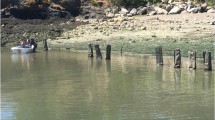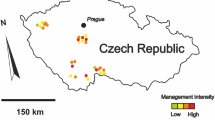Abstract
Salmon farming is a widespread activity around the world, also known to promote diverse environmental effects on aquatic ecosystems. However, information regarding the impact of salmon farming on bird assemblages is notably scarce. We hypothesize that salmon farming, by providing food subsidies and physical structures to birds, will change their local community structure. To test this hypothesis, we conducted a seasonal monitoring of bird richness, abundance, and composition at paired salmon pen and control plots in two marine and two lake sites in southern Chile, from fall 2002 to summer 2004. Overall, salmon farming had no significant effects on species richness, but bird abundance was significantly and noticeably higher in salmon pens than in controls. Such aggregation was mainly accounted for by the trophic guilds of omnivores, diving piscivores, carrion eaters, and perching piscivores, but not by invertebrate feeders, herbivores, and surface feeders. Species composition was also significantly and persistently different between salmon pens and controls within each lake or marine locality. The patterns described above remained consistent across environment types and seasons indicating that salmon farming is changing the community structure of birds in both lake and marine habitats by promoting functional and aggregation responses, particularly by favoring species with broader niches. Such local patterns may thus anticipate potential threats from the ongoing expansion of the salmon industry to neighboring areas in Chile, resulting in regional changes of bird communities, toward a less diverse one and dominated by opportunistic, common, and generalist species such as gulls, vultures, and cormorants.





Similar content being viewed by others
References
Andelt WF, Woolley TP, Hopper SN (1997) Effectiveness of barriers, pyrotechnics, flashing lights and scarey man for deterring heron predation on fish. Wildlife Soc B 25:686–694
Boxaspen K (2006) A review of the biology and genetics of sea lice. ICES J Mar Sci 63:1304–1316. doi:10.1016/j.icesjms.2006.04.017
Broyer J, Curtet L (2012) Biodiversity and fish farming intensification in French fishpond systems. Hydrobiologia 694:205–218. doi:10.1007/s10750-012-1162-5
Buschmann AH, Riquelme VA, Hernández-González MC, Varela D, Jiménez JE, Henríquez LA, Vergara PA, Guíñez R, Filún L (2006) A review of the impacts of salmonid farming on marine coastal ecosystems in the southeast Pacific. ICES J Mar Sci 63:1338–1345. doi:10.1016/j.icesjms.2006.04.021
Camus PA, Jaksic FM (2009) Piscicultura en Chile: entre la productividad y el deterioro ambiental (1856–2008). Pontificia Universidad Católica de Chile, Santiago de Chile
Carroll ML, Cochrane S, Fieler R, Velvin R, White P (2003) Organic enrichment of sediments from salmon farming in Norway: environmental factors, management practices, and monitoring techniques. Aquaculture 226:165–180. doi:10.1016/S0044-8486(03)00475-7
Clarke K (1993) Non-parametric multivariate analysis of changes in community structure. Aust J Ecol 18:117–143. doi:10.1111/j.1442-9993.1993.tb00438.x
Clarke K, Gorley RN (2006) PRIMER version 6: user manual/tutorial. PRIMER-E, Plymouth
Costello MJ (2006) Ecology of sea lice parasitic on farmed and wild fish. Trends Parasitol 22:475–483. doi:10.1016/j.pt.2006.08.006
Cursach J, Rau JR, Tobar CN (2010) Birds in a marine wetland of southern Chile. Rev Biol Mar Oceanogr 45:441–450
Cursach J, Suazo CG, Rau JR, Tobar CN, Gantz A (2011) Assemblage of birds in a mussel farm on Chiloé Island, southern Chile. Rev Biol Mar Oceanogr 46:243–247
Dempster T, Uglem I, Sanchez-Jerez P, Fernandez-Jover D, Bayle-Sempere J, Nilsen R, Bjorn PA (2009) Coastal salmon farms attract large and persistent aggregations of wild fish: an ecosystem effect. Mar Ecol Prog Ser 385:1–14. doi:10.3354/meps08050
Fasham MJR (1977) A comparison on nonmetric multidimensional scaling, principal components and reciprocal averaging for the ordination of simulated coenoclines, and coenoplanes. Ecology 58:551–561
Garay G, Johnson WE, Franklin WL (1991) Relative abundance of aquatic birds and their use of wetlands in the Patagonia of southern Chile. Rev Chil Hist Nat 64:127–137
Glahn JF, Dorr B, Tobin ME (2000) Captive great blue heron predation on channel catfish fingerlings. N Am J Aquacult 62:149–156. doi:10.1577/1548-8454(2000)062<0149:CGBHPO>2.0.CO;2
Glahn JF, Dorr B, Harrel JB, Khoo L (2002) Foraging ecology and depredation management of great blue herons at Mississippi catfish farms. J Wildl Manage 66:194–201
Godoy MG, Aedo A, Kibenge MJT, Groman DB, Yason CV, Grothusen H, Lisperguer A, Calbucura M, Avendaño F, Imilán M, Jarpa M, Kibenge FSB (2008) First detection, isolation and molecular characterization of infectious salmon anemia virus associated with clinical disease in farmed Atlantic salmon (Salmo salar) in Chile. BMC Vet Res 4:28. doi:10.1186/1746-6148-4-28
Gonzalez-Gajardo A, Sepulveda PV, Schlatter R (2009) Waterbird assemblages and habitat characteristics in wetlands: influence of temporal variability on species-habitat relationships. Waterbirds 32:225–233. doi:10.1675/063.032.0203
Habit E, Gonzalez J, Ruzzante DE, Walde SJ (2012) Native and introduced fish species richness in Chilean Patagonian lakes: inferences on invasion mechanisms using salmonid-free lakes. Diversity Distrib 18:1153–1165. doi:10.1111/j.1472-4642.2012.00906.x
Harris CM, Calladine JR, Wernham CV, Park KJ (2008) Impacts of piscivorous birds on salmonid populations and game fisheries in Scotland: a review. Wildlife Biol 14:395–411. doi:10.2981/0909-6396-14.4.395
Jansen A, Robertson AI (2001) Riparian bird communities in relation to land management practices in floodplain woodlands of south-eastern Australia. Biol Conserv 100:173–185. doi:10.1016/S0006-3207(00)00235-4
Jaramillo A (2003) Birds of Chile. Princeton University Press, New Jersey
Kloskowski J (2011a) Consequences of the size structure of fish populations for their effects on a generalist avian predator. Oecologia 166:517–530. doi:10.1007/s00442-010-1862-3
Kloskowski J (2011b) Human-wildlife conflicts at pond fisheries in eastern Poland: perceptions and management of wildlife damage. Eur J Wildlife Res 57:295–304. doi:10.1007/s10344-010-0426-5
Kloskowski J (2012) Fish stocking creates an ecological trap for an avian predator via effects on prey availability. Oikos 121:1567–1576. doi:10.1111/j.1600-0706.2011.19942.x
Kloskowski J, Green AJ, Polak M, Bustamante J, Krogulec J (2009) Complementary use of natural and artificial wetlands by waterbirds wintering in Doñana, south-west Spain. Aquat Conserv 19:815–826. doi:10.1002/aqc.1027
Kloskowski J, Nieoczym M, Polak M, Pitucha P (2010) Habitat selection by breeding waterbirds at ponds with size-structured fish populations. Naturwissenschaften 97:673–682. doi:10.1007/s00114-010-0684-9
Legendre P, Gallagher ED (2001) Ecologically meaninful transformation for ordination of species data. Oecologia 129:271–280. doi:10.1007/s004420100716
Lotze HK, Lenihan HS, Bourque BJ, Bradbury RH, Cooke RG, Kay MC, Kidwell SM, Kirby MX, Peterson CH, Jackson JBC (2006) Depletion, degradation, and recovery potential of estuaries and coastal seas. Science 312:1806–1809. doi:10.1126/science.1128035
Maricchiolo G, Mirto S, Caruso G, Caruso T, Bonaventura R, Celi M, Matranga V, Genovese L (2011) Welfare status of cage farmed European sea bass (Dicentrarchus labrax): a comparison between submerged and surface cages. Aquaculture 312:173–181. doi:10.1016/j.aquaculture.2011.02.001
McKinnney ML, Lockwood JL (1999) Biotic homogenization: a few winners replacing many losers in the next mass extinction. Trends Ecol Evol 14:450–453. doi:10.1016/S0169-5347(99)01679-1
Molinet C, Cáceres M, Gonzalez MT, Carvajal J, Asencio G, Díaz M, Díaz P, Castro MT, Codjambassis J (2011) Population dynamic of early stages of Caligus rogercresseyi in an embayment used for intensive salmon farms in Chilean inland seas. Aquaculture 312:62–71. doi:10.1016/j.aquaculture.2010.12.010
Naidoo R (2004) Species richness and community composition of songbirds in a tropical forest-agricultural landscape. Anim Conserv 7:93–105. doi:10.1017/S1367943003001185
Pitt WC, Conover MR (1996) Predation at intermountain west fish hatcheries. J Wildl Manage 69:616–624
Radovic A, Tepic N (2009) Overview of the bird community historical data: bird assemblage multivariate analysis of the data collected from five mountain areas in the northern Croatia. Folia Zool 58:216–227
Rosenberg R (2001) Marine benthic faunal successional stages and related sedimentary activity. Sci Mar 65:107–119. doi:10.3989/scimar.2001.65s2107
Soto D, Jara F, Moreno C (2001) Escaped salmon in the inner seas, southern Chile: facing ecological and social conflicts. Ecol Monogr 11:1750–1762
StatSoft (2004) STATISTICA (data analysis software system), version 7
Sullivan KL, Curtis PD, Chipman RB, McCullough RD (2006) The double-crested cormorant: issues and management. Cornell University, Department of Natural Resources, New York
Webb TJ, Dulvy NK, Jennings S, Polunin NVC (2011) The birds and the seas: body size reconciles differences in the abundance-occupancy relationship across marine and terrestrial vertebrates. Oikos 120:537–549. doi:10.1111/j.1600-0706.2011.18870.x
Worm B, Barbier EB, Beaumont N, Duffy JE, Folke C, Halpern BS, Jackson JBC, Lotze HK, Micheli F, Palumbi SR, Sala E, Selkoe KA, Stachowicz JJ, Watson R (2006) Impacts of biodiversity loss on ocean ecosystem services. Science 314:787–790. doi:10.1126/science.1132294
Wu RSS (1995) The environmental impact of marine fish culture: towards a sustainable future. Marine Poll Bull 31:159–166. doi:10.1016/0025-326X(95)00100-2
Acknowledgments
This study was supported by a grant (to JEJ) from the Research Division of Universidad de Los Lagos. We thank Marine Harvest and Multiexport for granting access to their fish farms at Calbuco and Puerto Fonck, respectively, and to the Experimental Aquaculture Centers of Limnology and Marine Sciences of Universidad de Los Lagos for their logistical support at Rupanco and Metri, respectively. The Birder Exchange program provided field equipment, and A.H. Navarrete helped with the nMDS analysis. We appreciate the English correction made by K. Moses. We also thank the comments of J.P. González-Varo. FEF was supported by a CONICYT doctoral fellowship.
Author information
Authors and Affiliations
Corresponding author
Additional information
Communicated by: Sven Thatje
Rights and permissions
About this article
Cite this article
Jiménez, J.E., Arriagada, A.M., Fontúrbel, F.E. et al. Effects of exotic fish farms on bird communities in lake and marine ecosystems. Naturwissenschaften 100, 779–787 (2013). https://doi.org/10.1007/s00114-013-1076-8
Received:
Revised:
Accepted:
Published:
Issue Date:
DOI: https://doi.org/10.1007/s00114-013-1076-8




